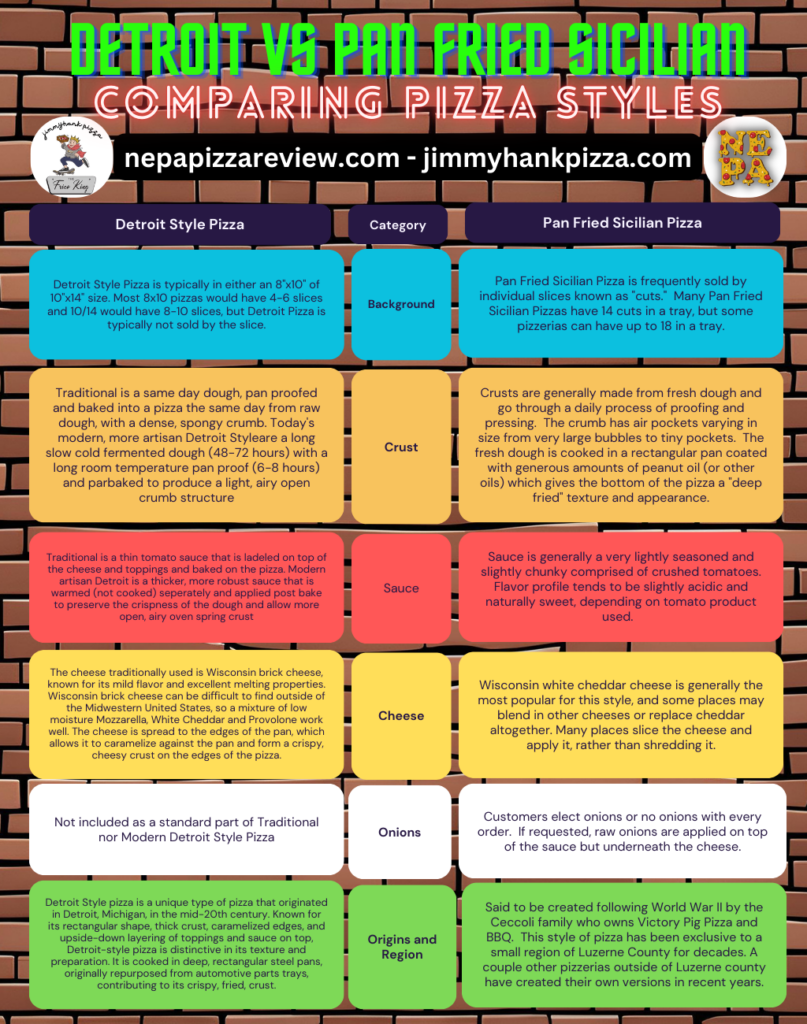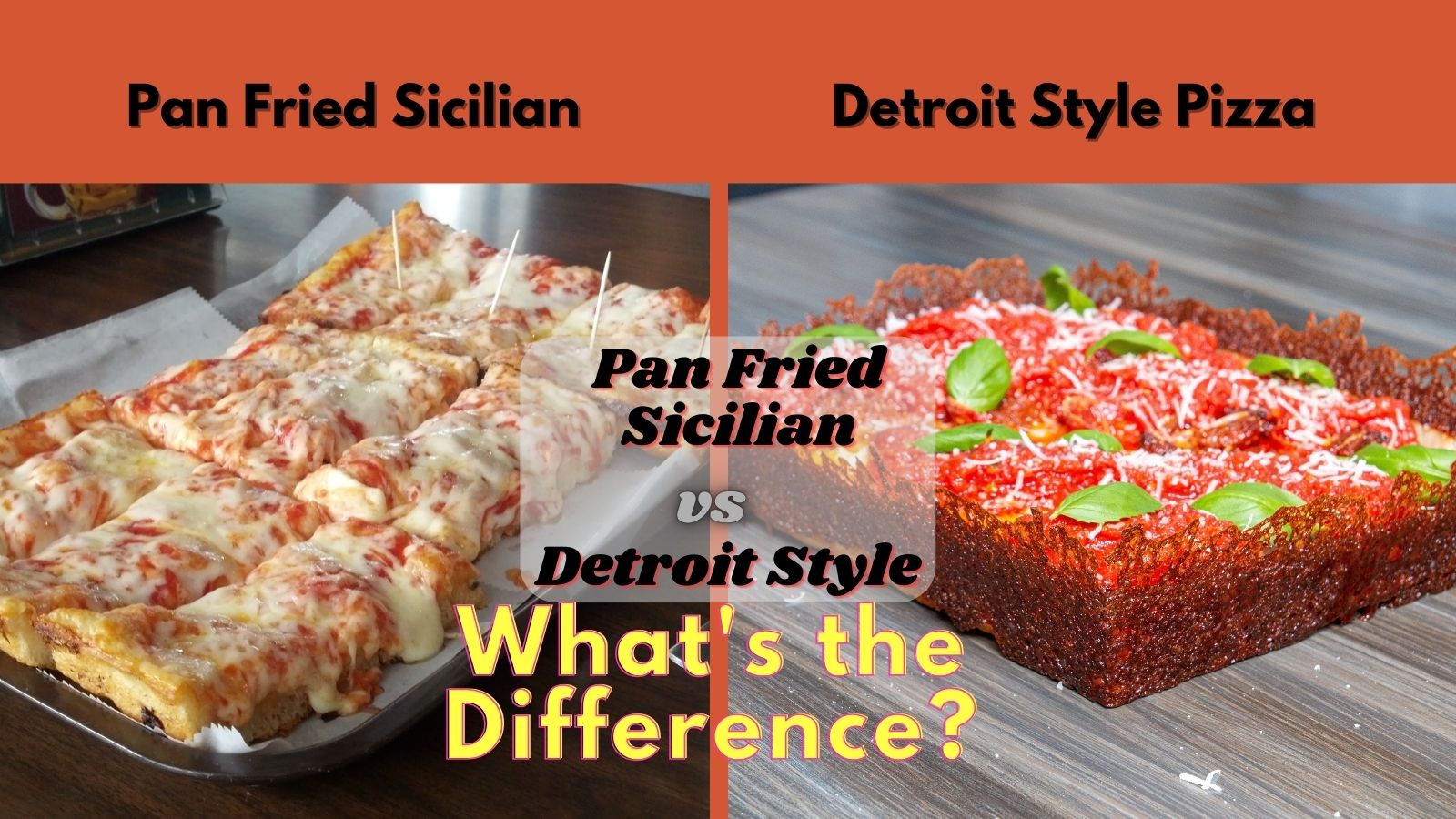Pan Fried Sicilian vs Detroit Style Pizza: What is the Difference?
When it comes to regional pizza styles, NEPA Pan Fried Sicilian Pizza and Detroit Style Pizza are two of the most frequently confused. At first glance, they may seem nearly identical, given their rectangular shape and the use of high-sided pans. However, upon closer examination, the differences in composition, dough preparation, baking techniques, and ingredients reveal that these are two very distinct styles of pizza.
Background & Origins
Detroit Style Pizza was born in Detroit, Michigan, in the mid-20th century. Originally baked in deep, rectangular steel pans repurposed from automotive parts trays, this pizza became known for its caramelized edges, thick crust, and upside-down layering technique where the sauce is applied last. Detroit pizza has gained nationwide recognition and is now found in pizzerias across the country.
In contrast, NEPA Pan Fried Sicilian Pizza is a regional specialty of Luzerne County, Pennsylvania, with a history tied to Victory Pig Pizza and BBQ, where it is believed to have originated post-World War II. Other popular establishments serving this style include Pizza L’Oven and Pizza Perfect. Unlike Detroit Style Pizza, Pan Fried Sicilian Pizza has remained largely exclusive to this small region, with only a handful of pizzerias outside the area attempting to replicate it.
Crust & Dough Preparation
The crust is where these two styles differ the most. Detroit Style Pizza utilizes either a same-day dense dough or a long cold-fermented artisan dough (48-72 hours), with the latter yielding a light, airy, open-crumb structure. The dough is pan-proofed and sometimes parbaked to enhance the final texture.
Conversely, Pan Fried Sicilian Pizza employs a daily proofed fresh dough that is pressed into the pan. What sets this style apart is its cooking process—rectangular pans are coated in a generous amount of peanut oil (or another high-heat oil), creating a distinctive “deep-fried” bottom crust. This results in a crispy, golden base with a structure that contains air pockets of varying sizes, from large bubbles to tiny holes.
Sauce
Both styles feature a tomato-based sauce, but the application and consistency vary significantly:
- Detroit Style Pizza traditionally has a thin tomato sauce ladled on top of the cheese and toppings before baking. However, modern artisan variations opt for a thicker, robust sauce applied post-bake to maintain a crispier crust.
- NEPA Pan Fried Sicilian Pizza uses a lightly seasoned, slightly chunky sauce made from crushed tomatoes, giving it a naturally sweet and slightly acidic flavor. The sauce is applied under the cheese rather than on top.
Cheese
A signature element of Detroit Style Pizza is Wisconsin brick cheese, known for its mild flavor and exceptional melting properties. However, since this cheese is difficult to find outside the Midwest, some pizzerias substitute a blend of low-moisture mozzarella, white cheddar, and provolone. Crucially, the cheese is spread to the pan’s edges, creating a caramelized, crispy cheese crust that is one of Detroit pizza’s hallmarks.
On the other hand, NEPA Pan Fried Sicilian Pizza is most commonly topped with Wisconsin white cheddar cheese, though some variations include blends or replacements with other cheeses. A distinctive technique of this style is that the cheese is often sliced rather than shredded before being layered on the pizza.
Onions: A Unique Option in Pan Fried Sicilian Pizza
One notable distinction is the inclusion of onions in Pan Fried Sicilian Pizza. Unlike Detroit Style Pizza, which does not include onions as a standard topping, customers ordering Pan Fried Sicilian Pizza can request raw onions, which are applied under the cheese but above the sauce before baking.
Sizing & Serving Differences
The serving methods of these two pizzas also set them apart:
- Detroit Style Pizza is typically not sold by the slice but rather as a whole pizza. It comes in either 8″x10″ (4-6 slices) or 10″x14″ (8-10 slices).
- NEPA Pan Fried Sicilian Pizza is more commonly sold by individual slices, known as “cuts.” A full tray often contains 14-18 cuts, depending on the pizzeria.

Final Thoughts: Similar Yet Distinct
While both NEPA Pan Fried Sicilian Pizza and Detroit Style Pizza share a rectangular shape and high-sided baking pans, the differences in dough fermentation, baking techniques, sauce application, cheese composition, and serving methods make them distinctively different pizzas. Detroit pizza leans toward a light and airy crumb with caramelized cheese edges, while Pan Fried Sicilian pizza boasts a crispy, deep-fried bottom and a unique cut-serving style.
For pizza lovers looking to explore unique regional styles, trying both of these delicious pizzas is a must. While they might look similar at a glance, once you take a bite, their differences become unmistakably clear!
READ: What is the Difference Between Old Forge Pizza and Pan Fried Sicilian Pizza?
Want to make NEPA Pan Fried Sicilian Pizza at Home? Check out my easy to use PFS recipe!

About the Authors
This article was co-authored by Jim Mirabelli of NEPA Pizza Review and Jim Henry of JimmyHank Pizza. Jim Mirabelli has been reviewing and making Pan Fried Sicilian Pizza in Northeastern Pennsylvania for more than 12 years. Jim Henry, also known as “The Frico King” is known for his signature elevated artisanal Detroit Style pizza which he competes with nationally each year at Pizza Expo.





